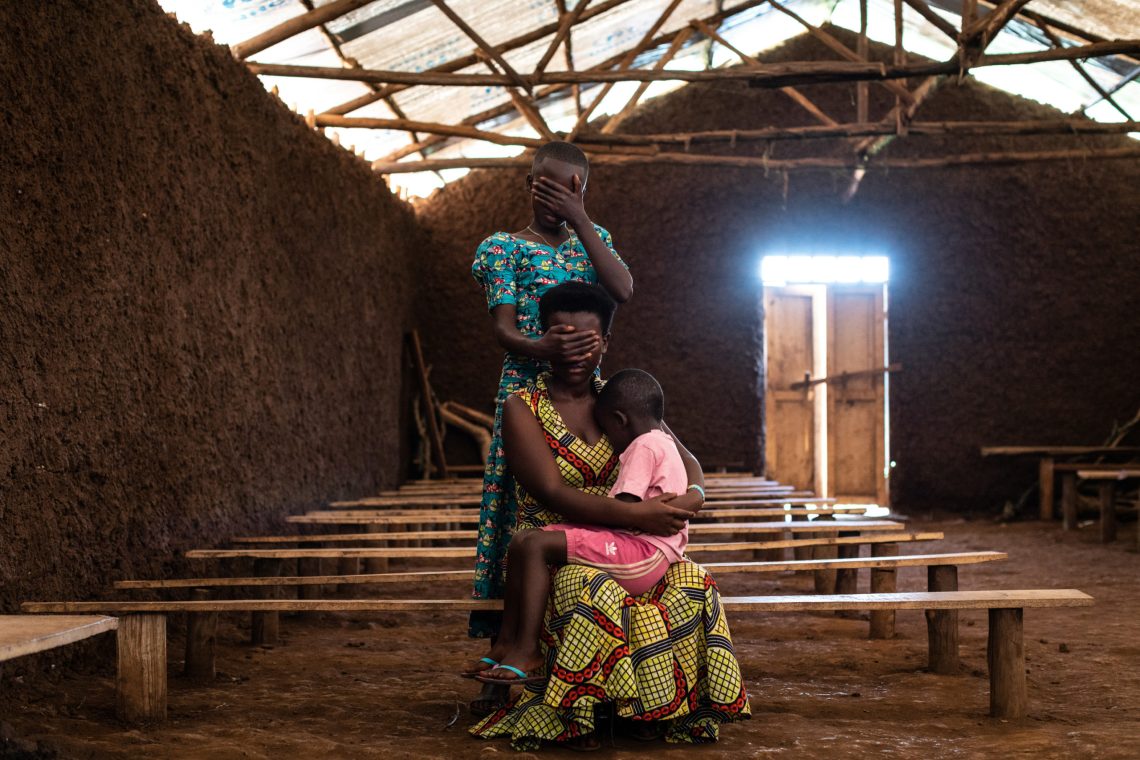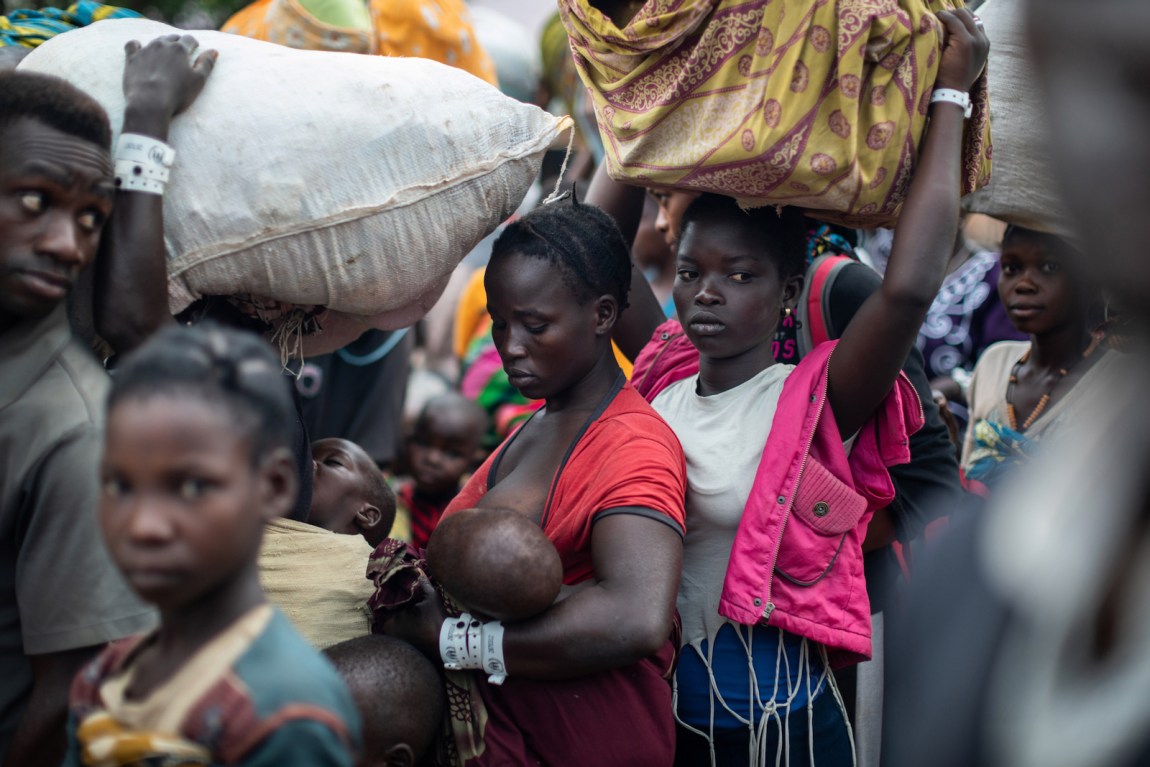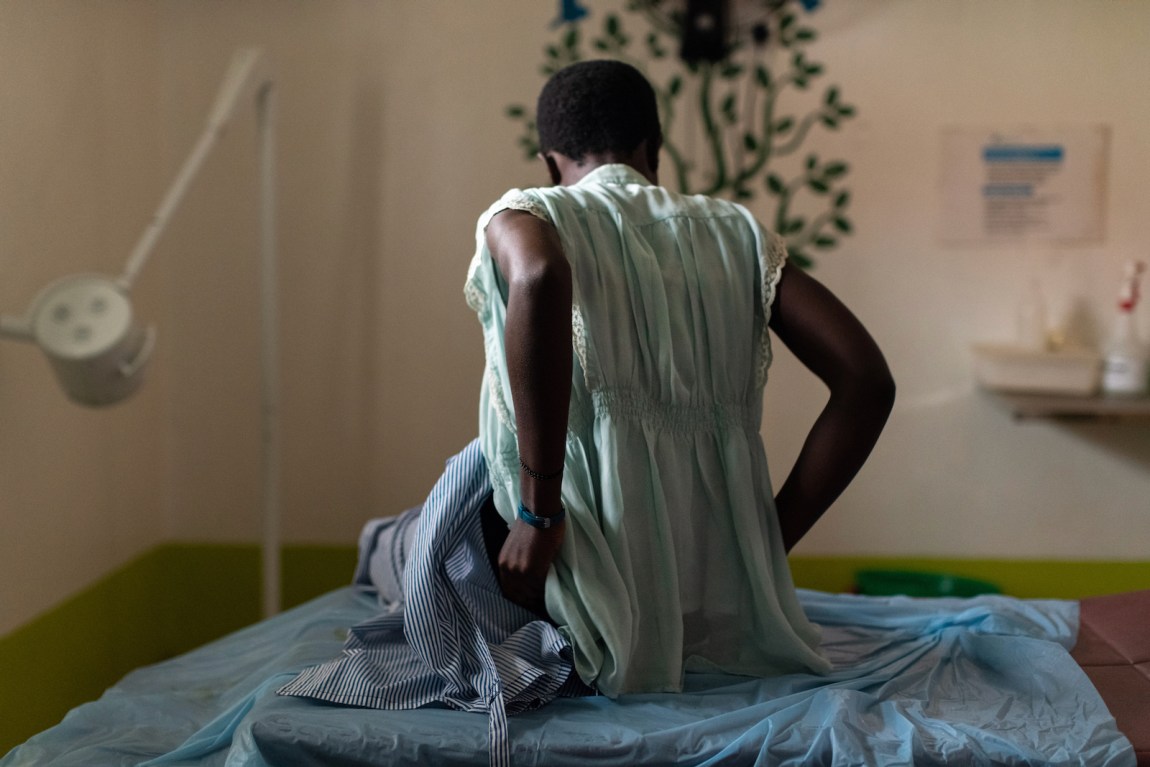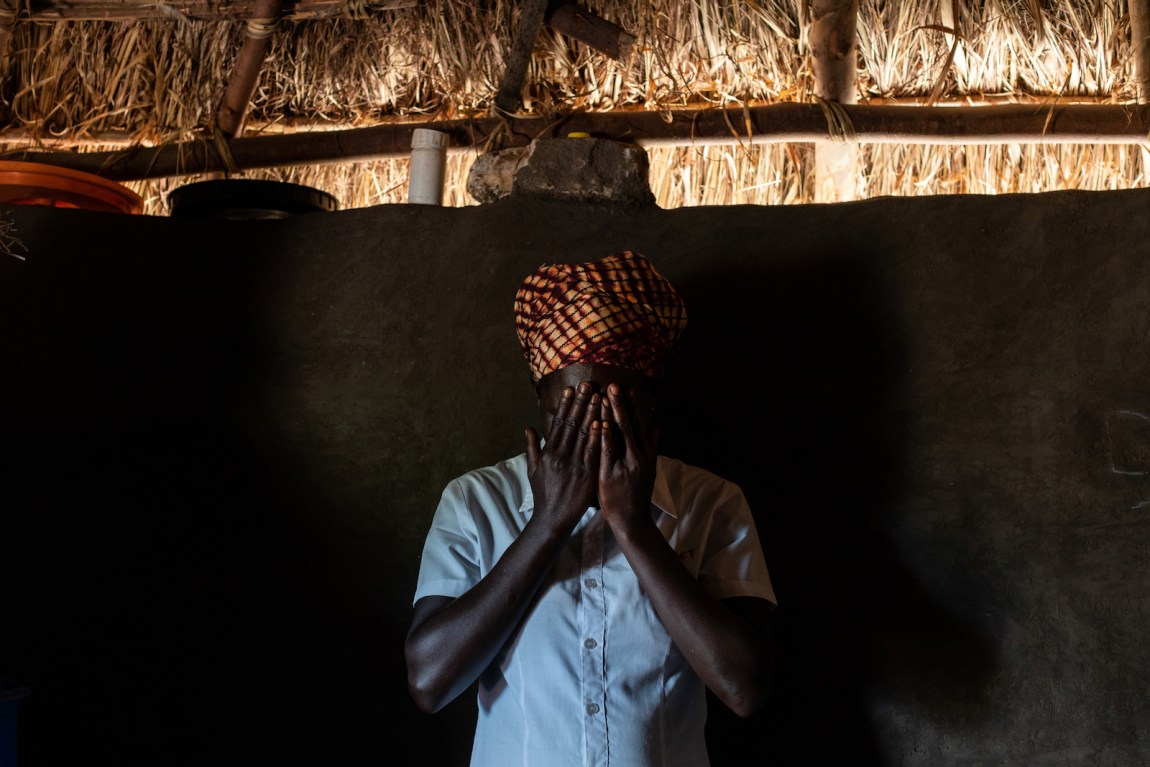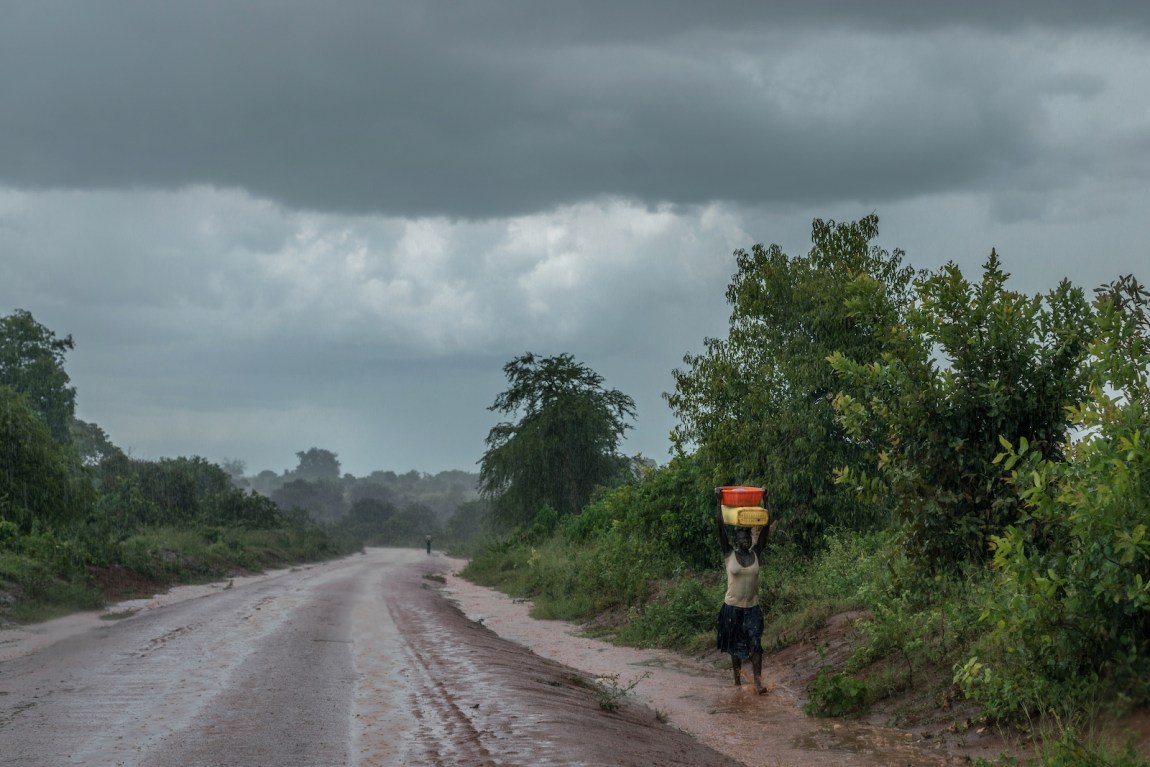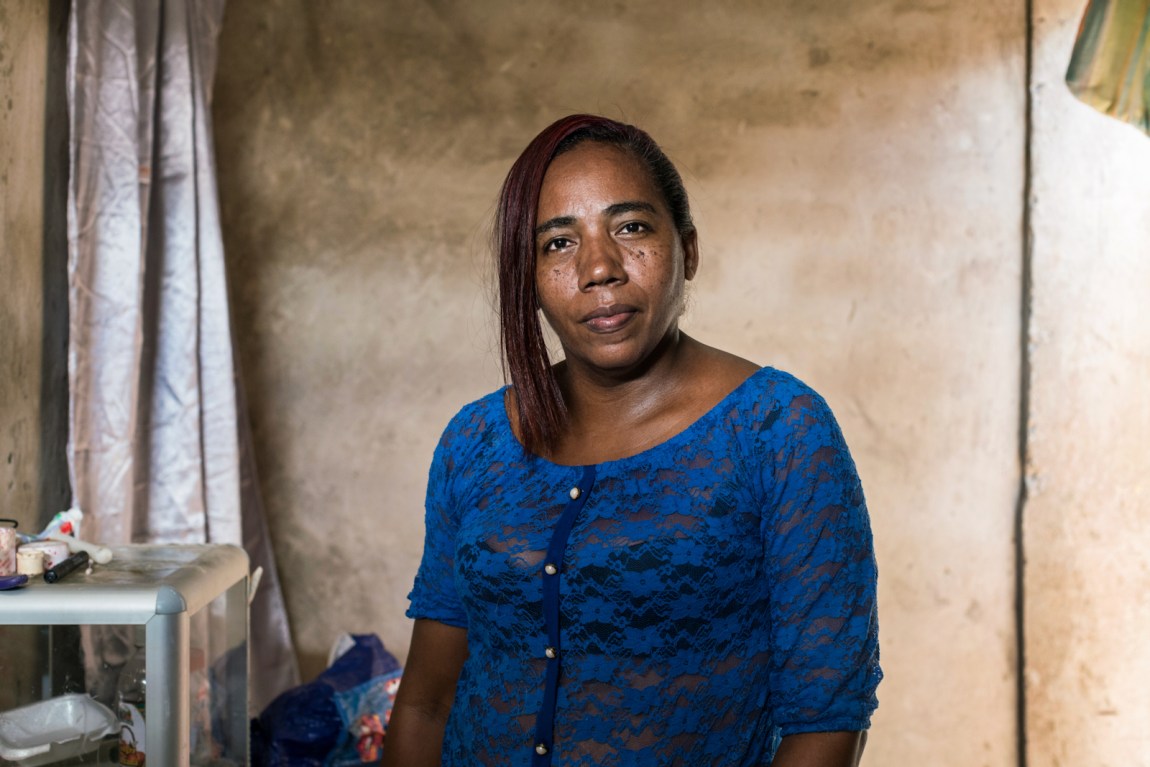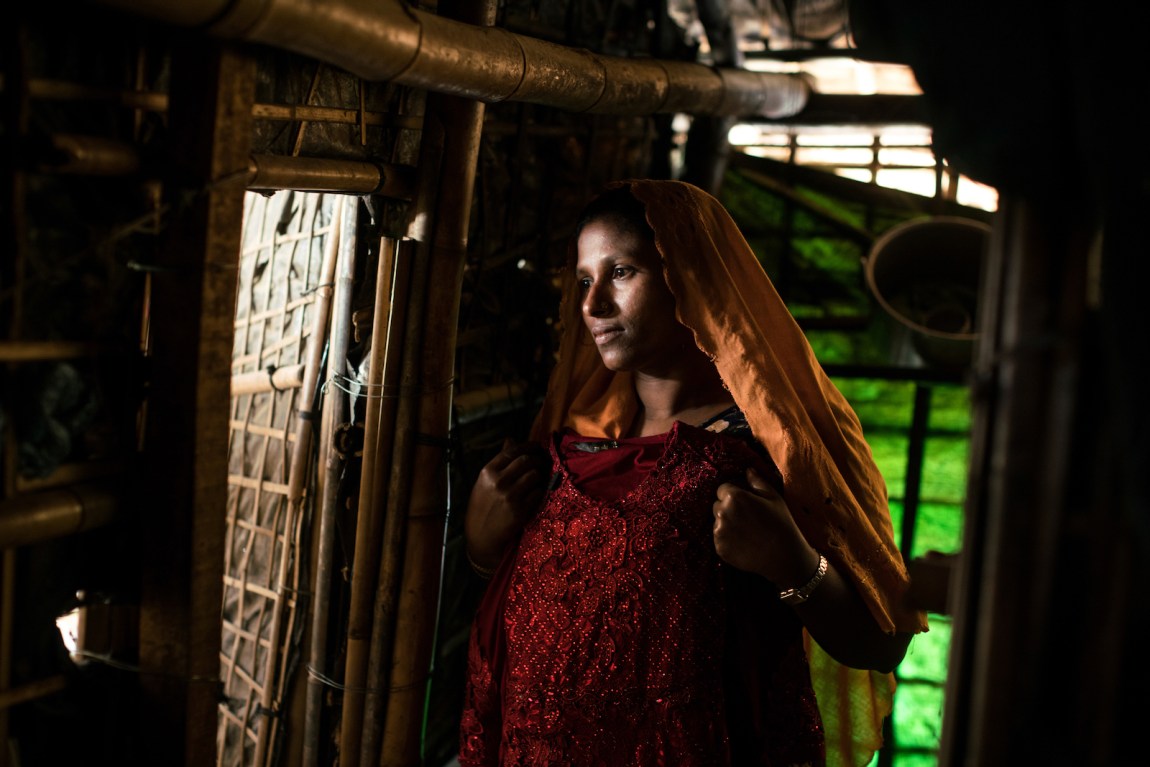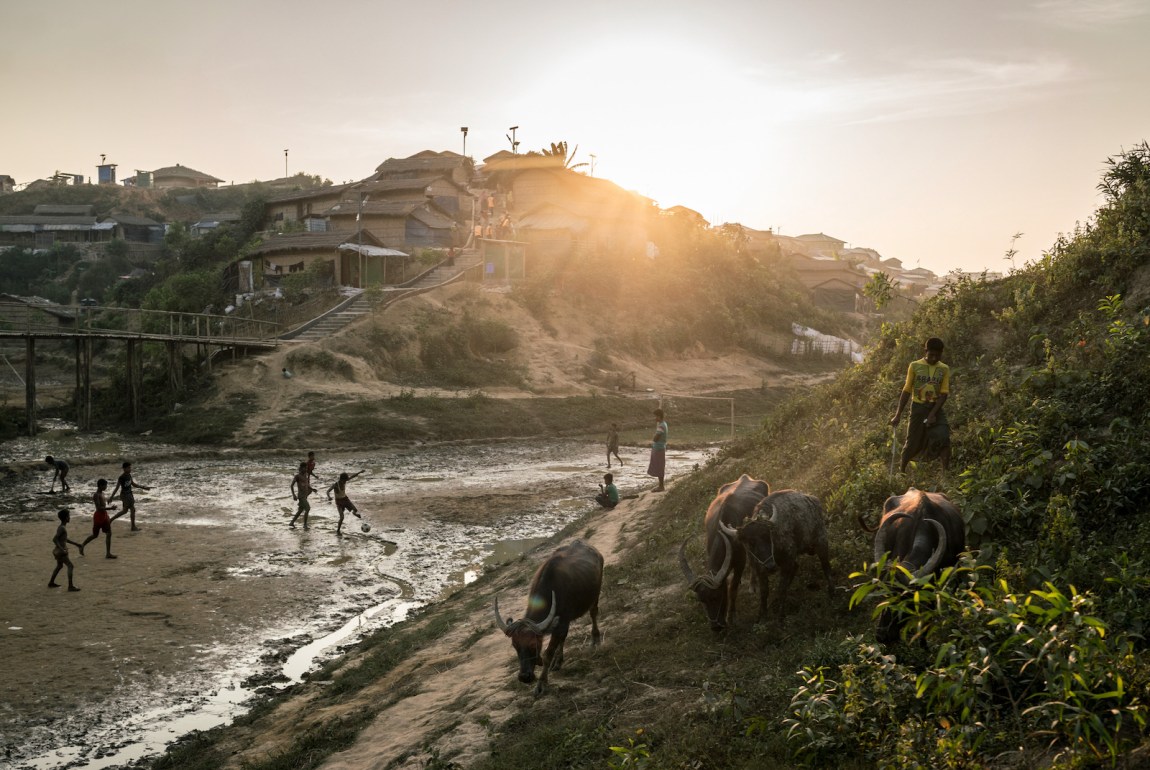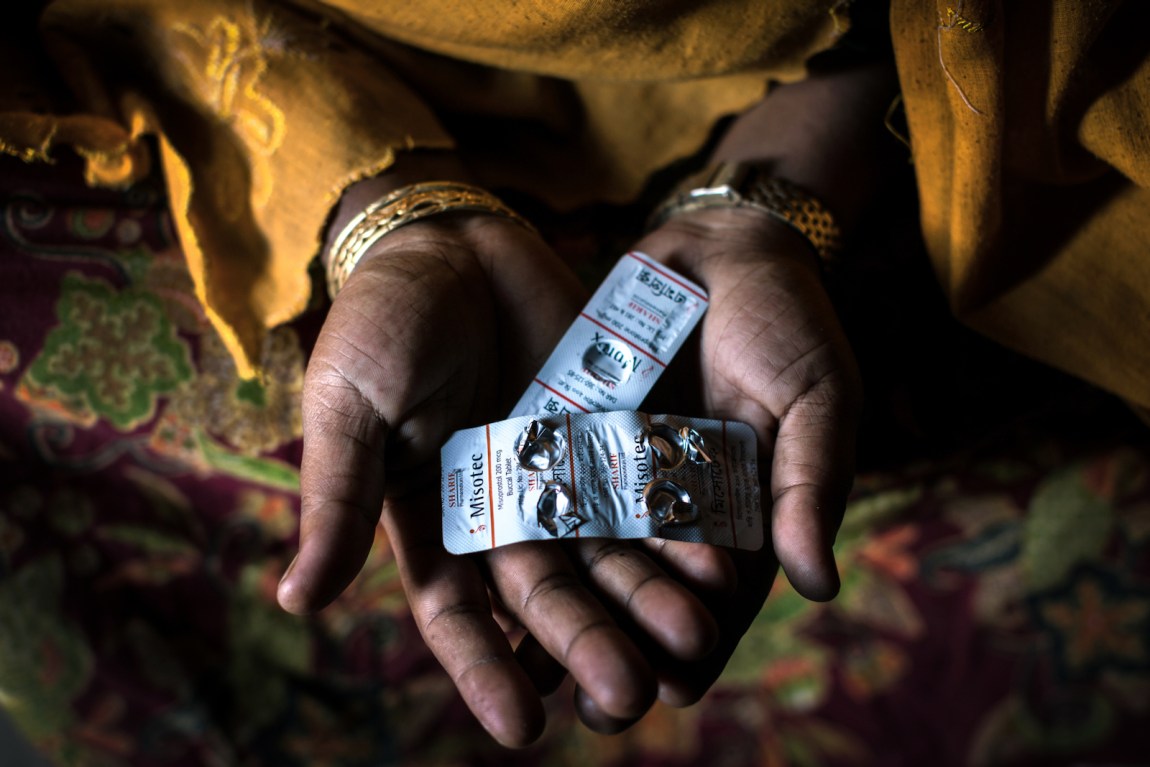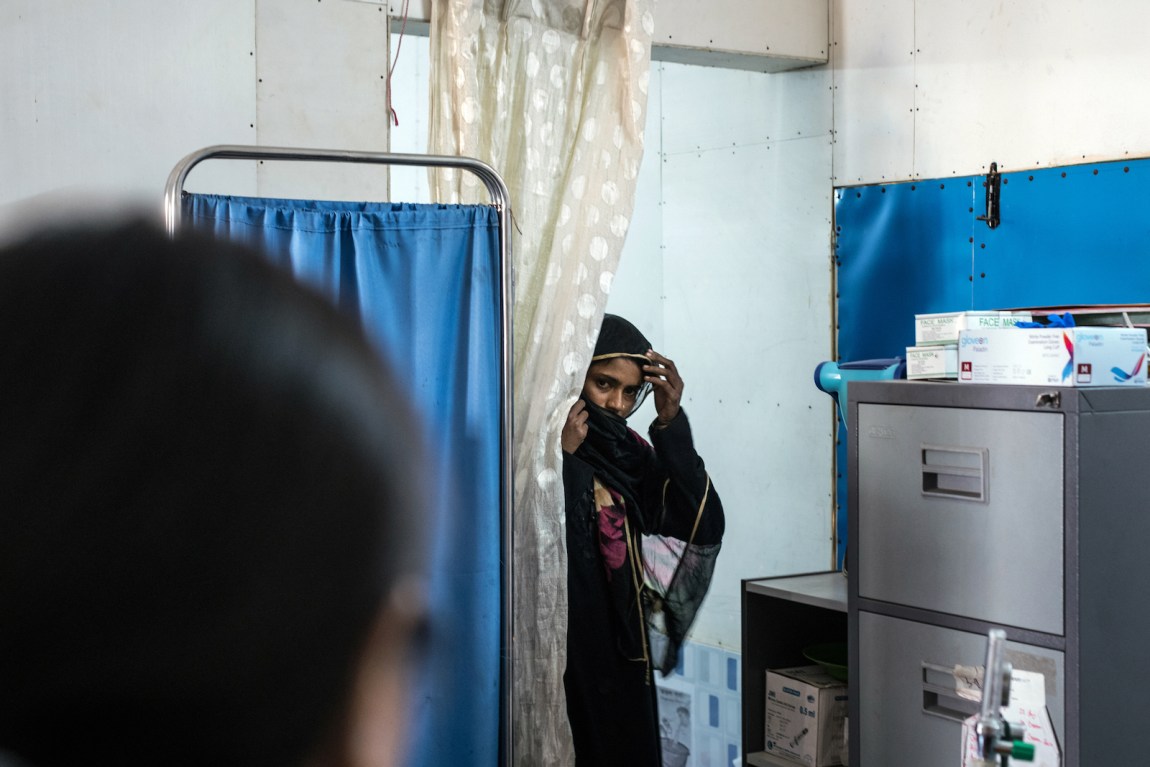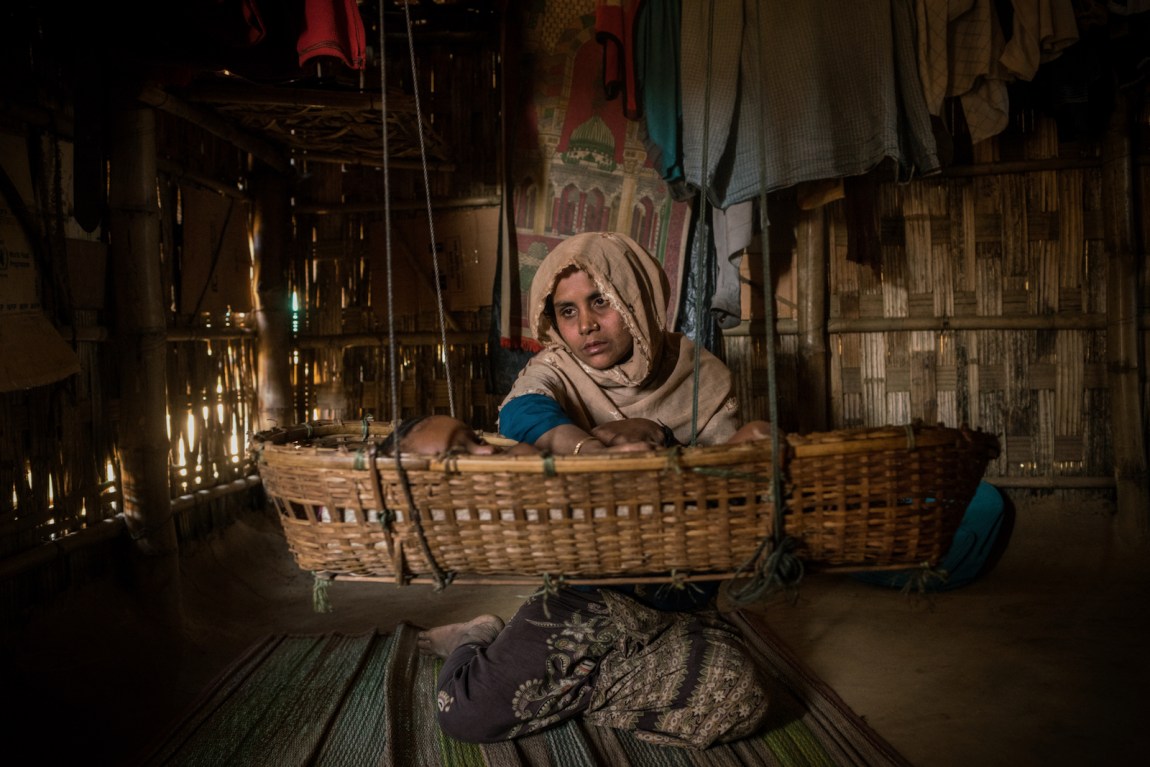Rwenyawawa hospital was packed. Hundreds of women, most of them with babies slung across their backs or weighing heavily in their arms, crowded under the tin roofs of the vast open-air waiting areas, standing by with the resigned patience of people who are used to waiting. Uganda is home to more refugees than any other African country, and the hospital was building an addition to keep up with demand. In a typical month, doctors and midwives at Rwenyawawa assist with some 80 to 120 deliveries, and thousands of other patients come in for so much more—vaccinations, baby checkups, persistent pain.
Inside the maternity ward, women with skin still moist with sweat from laboring in childbirth were lying two to a single metal bed, heavily swaddled infants curled at their breasts. Today, a doctor said, is a slow day. Often, each bed has to fit three.
And sexual violence? Do they see such cases? A midwife raised a sardonic eyebrow. “This is a camp,” she said. (Medical staff I spoke to were not permitted to speak on the record, so I have granted them anonymity for this reporting; likewise, I have where necessary used pseudonyms or first names only to protect subjects’ privacy or security.)
Rape is an endemic aspect of conflict, inflicted by soldiers, militants, and other fighters on civilians. While it can hardly be explained away as inevitable, the use of rape to punish, demoralize, or even destroy particular populations has been documented from ancient Greece through the twentieth century’s two world wars and the Rwandan and Bosnian genocides of the 1990s, to, most recently, the Ethiopian government’s offensive in the country’s Tigray region, where women, health workers, and human rights observers have reported mass sexual violence. Many survivors of sexual violence wind up in refugee settlements—only to find that it follows them there, for rape and other forms of sexual assault are ubiquitous in refugee camps, too.
Rwenyawawa hospital is in the Kyangwali refugee settlement in western Uganda, near the shores of Lake Albert, which forms part of the country’s border with the Democratic Republic of Congo. Although the protracted Congolese civil war technically ended in 2003, conflict over land, power, and resources continues to this day—forcing waves of refugees to flee their villages. There are 4.5 million people displaced within Congo, and nearly a million refugees in neighboring African nations. Most of the people who wind up in the Kyangwali camp—overwhelmingly women and children—can’t tell you what exactly all the fighting is for. But when men with guns show up, it’s time to go.
The war came to Sarah as she was walking home from school, showing up in the form of four young men toting firearms, axes, and machetes. “Don’t you see war is here?” one asked before he and his compatriots took Sarah, her cousin Florence, and her best friend Bettina into the trees.
It had been important to Sarah to learn to read. She was an orphan being raised by an aunt, the youngest of six children in the house, and so she knew she had to make something of herself; no one else was going to look out for her. She thought maybe she would like to be a judge, to mete out a little fairness in a world that felt not only unjust but often incomprehensible. The war snatched that dream away. Living in a refugee settlement, she said, “we are given books for people who are raped. That’s what we are reading.”
After the men were done with Sarah and her friends, they took their machetes to Florence, but let Sarah and Bettina go. The girls ran, and Sarah found an older woman she knew, a fish-seller who went to her church. The fish-seller took Sarah, who is small and skinny, along with her into the bush, just the two of them. They waited until nightfall to move from one hiding place to another.
Eventually, they reached the village of Chomya in Congo, where Sarah found her aunt, and they all piled into a wooden boat and crossed Lake Albert into Uganda together. Sarah arrived feverish with malaria, and after giving her basic treatment, aid workers brought her to Rwenyawawa for more care. There was good news: she didn’t have HIV. And bad news: she was pregnant. Sarah was fourteen years old.
*
Women often come to Rwenyawawa asking for abortions, or, more commonly, for help after they’ve tried to give an abortion to themselves. For those women who have tried to self-induce, the hospital can help, using medication or a simple procedure to complete a partial abortion and often save a woman’s life. For the others—those who, like Sarah, come in pregnant, often from rape, and see no future in raising a child in the bleak surroundings of a refugee settlement—there is little health care providers can say, other than “no.”
Advertisement
They say no a lot.
The problem isn’t just that abortion laws in Uganda are conservative and contradictory (the law says abortion is legal only to save a woman’s health or life, while the Ugandan Ministry of Health’s national guidelines say abortion should be on offer for rape survivors). Rwenyawawa is in a refugee camp, which is subject to a combination of restrictive local laws, humanitarian timidity, and America’s abortion politics. This produces a singular result: even though everyone knows rape is endemic in conflict and that pregnancies from rape abound in refugee settings, terminating a pregnancy is stigmatized and almost universally out of reach for these women, some of the world’s most vulnerable.
This is despite the fact that most countries with large refugee populations officially permit abortions for rape survivors—and that US law, in theory, allows USAID dollars to fund them. The 1973 Helms Amendment to the Foreign Assistance Act came into force after the Roe v. Wade decision in the United States legalized abortion nationwide, and it bars US money from funding “abortion as a method of family planning [my emphasis].” That language leaves open the option for USAID to pay for abortions required for other reasons: to preserve a pregnant woman’s life or health, or to end a pregnancy caused by rape or incest. In practice, however, USAID does not fund abortions for rape survivors, or anyone. That is enormously influential, because the United States is the largest global health funder in the world.
All of these restrictions predate the presidency of Donald Trump, and they remained in place after he left office. Even under Democratic presidents, US backing for women’s reproductive health is tepid, and support for abortion virtually nonexistent. Yet Trump’s team made unprecedented attacks on women’s health, including basic care for rape victims. It was a disaster for the world’s women. But the administration’s aggressive stance highlighted the degree to which an overreliance on US largesse has made global health work a hostage to America’s deadlocked, antagonistic domestic politics of abortion. And it had one significant, if inadvertent, outcome: private philanthropists, innovative human rights lawyers, and more progressive nations are now taking a bolder stance—asking: Why shouldn’t refugee women raped in conflict be entitled to safe abortions?
“We do reproductive health, they are looking at us like we are Jesus coming,” said a midwife who works at Rwenyawawa. She was committed to helping women, but as a devout Christian, she had been uncomfortable with abortion. But working in Kyangwali changed her. “I think I got radical,” she said. She had seen so many young women, girls like Sarah, come in after being raped, wanting to end their pregnancies; all she could tell them was no. After refusing to help, she said, “You go back home and you say, What solution have I done? She came with so much hope.”
Sometimes, the women she turned away would take matters into their own hands—and then she might see them back at the hospital, needing treatment for botched attempts at self-inducing, or worse. “One girl, I counseled her, but unfortunately we think she committed suicide,” the midwife said. “She was found dead.”
When Sarah found out she was pregnant, “I cried,” she said. “I’m still young, I told myself. How could I carry the baby in my womb?” But there was no other choice. If she had been offered a safe abortion, Sarah said, she would have had one. But no one at the hospital mentioned it. And so, Sarah, barely a teenager, became an unwilling mother. Even now, she said, “when I hold my baby, it reminds me of what I’ve gone through.” She cried again, as she was telling her story; her baby, not quite two, reached up toward her tears and cried with her.
*
Back in 2010, a United Nations official called the Democratic Republic of Congo “the rape capital of the world.” Today, the DRC has a few competitors for that grim distinction—but one is its neighbor South Sudan, the world’s newest country, which gained its independence in 2011.
In Bidi Bidi, a group of settlements in northwestern Uganda some four hundred miles from Kyangwali, most of the nearly one million resident refugees are from South Sudan, and most are women and children. South Sudan has been engulfed in a bloody civil war since 2013, and even after a peace deal was signed in 2018, soldiers on all sides of the conflict have used rape to terrorize and torture their perceived opponents at a scale one UN expert called “frankly mind boggling.”
Advertisement
Until 2017, Bidi Bidi was the largest refugee camp in the world. While it is safer than a homeland devastated by war, it’s also a treacherous place to be female: women and girls experience widespread abuse, in their own homes and outside of them.
Solomon Omodi is a child protection worker here, and there is a lot of work to be done. More than half of girls in South Sudan are married before they turn eighteen, and nearly one in ten are wed before the age of fifteen. Those norms are not left behind when families flee war; researchers have found that in other refugee settings, child marriage rises as a result of displacement. So does the risk of sexual assault. For the girls Omodi and other child protection officers are charged with defending, early marriage and sexual violence are not just problems of custom and law but matters of life and death: complications from pregnancy and childbirth are the leading global killer of girls aged fifteen to nineteen.
“Almost all of the girls here, they do not want to get pregnant, but it is forced on them,” Omodi said. And when they do get pregnant, “we find that they want to have the abortion.” Some girls move away to other settlements and have their babies in secret. Some give birth and then abandon or kill their infants. Others try to end their pregnancies by taking ulcer drugs or local herbs; some dig up tree roots in an effort to make their own abortifacients.
“Sometimes, you hear they use Duracells,” he said, referring to a practice of steeping batteries in water and drinking the liquid. Omodi works for World Vision, a US-based “global Christian humanitarian organization,” in its own words, that opposes not just abortion but many of the most effective modern contraceptive methods. Even if safe abortion were more easily available in Bidi Bidi, his group, which, as of 2020, ranked sixth-largest for implementing USAID grants among similar agencies, would not help a pregnant child get one. In any case, the girls in the camp are too scared to talk about it. “It is mostly fear,” Omodi said. “Fear of the parents and of the child protection partners, World Vision. Because we discourage [abortion].”
Anita used herbs. Growing up on a farm near Juba, the South Sudanese capital, life was fine, if a little monotonous. The last of twelve children, she worked on the family farm, and although there wasn’t a school in her village, she thought she would like to become a teacher someday.
In 2017, the Sudan People’s Liberation Movement-in-Opposition, the main antigovernment force in South Sudan, raided Anita’s village. They killed one of her brothers as he played cards and left his body on the side of the road. The remaining siblings decided to get out and began the two-day-long walk to the border. Anita, then twenty-three, traveled with her thirty-three-year-old husband, whom she had married earlier that year.
Anita arrived at Bidi Bidi already five months pregnant, and after a difficult birth had a baby girl by C-section at the hospital. Operating rooms are few and far between in refugee settlements, and it’s not easy to get a steady supply of blood. Doctors told her a second difficult birth could be a death sentence and encouraged her either to use contraception or to abstain from sex until she recovered. Anita’s husband, who has four wives and sixteen children (“and still adding more,” Anita said), disagreed. He beat her and raped her. Two weeks later, after Anita started noticing the same signs of pregnancy that she’d experienced with her daughter, a neighbor offered her something she said might help: a bitter root, found locally, that can be pounded, mixed with water, and drunk to induce a miscarriage.
After drinking the concoction, “I wanted to die,” Anita said. After her stomach swelled and started making noises that terrified her, she went to the local women’s center, where a social worker took her to a clinic at a nearby village. There, doctors told her that a delay in treatment could cost her her life, but that the treatment she needed was too complicated for their rudimentary facility. They referred her to a larger hospital in the town of Arua, some fifty miles southwest, where she had a postabortion care procedure to complete the miscarriage. When it was over, and she found out she was no longer pregnant, she said, “I became very happy.”
The very state of being pregnant is hazardous for women fleeing conflict or caught up in it. The thirty-five countries affected by war or otherwise defined as fragile states in 2016 accounted for less than a fifth of the world’s population, but for nearly two in three maternal deaths. In South Sudan, Anita’s homeland, the lifetime risk of dying during pregnancy or childbirth is one in eighteen. In the Democratic Republic of Congo, where Sarah is from, it’s one in thirty-four, and in Uganda, one in forty-nine. In Norway, it’s less than one in 25,000.
Although there are no reliable numbers on self-induced abortion in refugee camps, and no one knows exactly how many refugee women die of unsafe abortions every year, there is good reason to believe hazardous procedures are common. We do have solid data on the high rates of sexual violence against refugee women and girls: researchers have thoroughly documented this and, unsurprisingly, found links between rape and unplanned pregnancy. Worldwide, 61 percent of unplanned pregnancies end in abortion, and unsafe abortions cause an estimated 13 percent of pregnancy-related deaths worldwide. Every year, mothers who die from unsafe abortion leave behind some 220,000 children. Another five million women worldwide are hospitalized annually with complications from unsafe abortion; this is a phenomenon restricted almost exclusively to developing countries that limit abortion access.
“All the research around the world shows us the same thing,” said Angel Foster, a medical doctor, professor, and reproductive health researcher who was, from 2011 until 2016, the Echo’s Endowed Chair of Women’s Health Research at the University of Ottawa. “Which is that when women become pregnant and they don’t want to be, women have abortions.” There’s no reason, Foster said, that it would be any different for women living a refugee camp—except insofar as unsafe abortions are probably more common.
While US dollars will not pay for the safe, legal abortions that are lower risk than a shot of penicillin, they will fund the kind of postabortion care that Anita had. Médecins Sans Frontières (MSF), or Doctors Without Borders, provided postabortion care to more than 14,700 women in 2020 alone. Save the Children, which during the Trump administration agreed to abide by US restrictions on which services they could provide, documented 1,412 postabortion care patients in one year in the health facilities they support in just a single province in Congo.
Postabortion care typically entails either the administration of a medication or a vacuum aspiration procedure. Unsafe abortion occurs often enough that health care providers in humanitarian settings the world over have the necessary training and tools for postabortion care, even in the most difficult of circumstances. This means that safe abortion is, in effect, “already baked into emergency obstetric care,” noted Foster. If health care workers can provide postabortion care, they can provide abortion: it’s either the same procedure with the same instruments, or the dispensation of the same pills; the only difference might be medication dosage.
The problem of how to reduce rates of unsafe abortion among refugee women—and, by extension, cut the catastrophic numbers of maternal injuries and deaths—is, in Foster’s view, a more or less already “solved public health question.” The only missing part of the equation is will—including the US’s willingness to pay for safe abortions instead of dedicating funds only to patch women up after they’ve had dangerous ones. The unsolved issue is not a lack of information, potential funding, or logistical capability; it’s politics.
*
Rape in war may be as old as war itself, but for most of recorded history, rape was put in the same category as pillaging, a distasteful but expected form of collateral damage springing from the inevitable brutality of violent conflict. Rape in war was recognized as a crime against humanity under customary law—that is, according to well-established norms of engagement and patterns of punishment, if not codified into treaties or laws—but it wasn’t until after the mass killings in Rwanda and Bosnia in the 1990s that international human rights courts officially acknowledged rape as a means of genocide, and only then did reporters begin to consistently document rape as a war crime.
Between April 7 and July 15, 1994, members of Rwanda’s Hutu majority systematically slaughtered some 800,000 of their fellow citizens, mostly members of the country’s Tutsi minority. Part of this campaign of terror was the rape of an estimated quarter-million women by militiamen and Hutu civilians, including explicit attempts to impregnate Tutsi women and girls with the aim of forcing them to have what, in a patrilineal society, would be Hutu babies. No one knows precisely how many women were impregnated by rape during the Rwandan genocide—estimates range from the thousands to the tens of thousands—but there is no dispute that sexual violence was rampant.
During the Bosnian war (1992–1995), journalists and human rights investigators discovered Serbian-run concentration camps where Bosnian Muslims were starved, beaten, and sexually tortured. Between 20,000 and 50,000 women were sexually violated during the war, in what the UN called “a systematic rape policy.” This was corroborated by a 1994 letter from the then UN secretary general, Boutros Boutros-Ghali, which added that “some captors also state that they are trying to impregnate the women.” The prevalence of documented accounts and, perhaps, their sheer proximity to European capitals radically altered public awareness of “rape as a weapon of war.”
“When I began my doctoral dissertation in 1993 on how to prosecute war crimes against women, I often heard doubt expressed that rape was even a war crime,” wrote Kelly Askin, a legal adviser to the judges of the International Criminal Tribunals for the former Yugoslavia and for Rwanda, in a 2013 piece for the Open Society Justice Initiative. “It was regarded as an inevitable consequence of conflict or a mere by-product of war waged by men.”
That changed after the international community formed legal tribunals to hold Serbian and Rwandan perpetrators accountable, even if it wasn’t the first time that rape had been punished as a war crime or presented as evidence of those crimes. “I want to disabuse us of that notion that nothing happened until 1994,” said Patricia Sellers, an international criminal lawyer who advises the International Criminal Court and worked on the International Criminal Tribunals for Rwanda and Yugoslavia. “When these judicial mechanisms have been set up, the initial ones looked at customary law, and one of the customary provisions is that rape is a crime against humanity.” Rape and sexual violence were included in testimony presented at the Nuremberg tribunal, and were among the criminal conduct adjudicated by it, although rape was absent from the final judgment; Japanese officials and military officers were also convicted of a laundry list of charges, including rape, in the 1946 Tokyo tribunal. But the Rwanda tribunal itself noted “the historical exclusion of rape and other forms of sexual violence from the investigation and prosecution of war crimes.” And its finding that rape was an act of genocide was new—a ruling, Sellers said, that was the first in “what has become a body of jurisprudence that looks at sexual violence under various provisions of war crimes, crimes against humanity, and genocide.”
After the work of the Rwanda and Yugoslavia tribunals, media outlets began paying more attention to pregnancy as a result of rape in conflict, and particularly to the question of what happened to children conceived by rape. A 1996 New York Times article documented Rwanda’s thousands of “enfants de mauvais souvenir,” or children of bad memory, as they were known locally.
“Since abortion is illegal here, many of the women resorted to back-alley abortions rather than bear the children,” Times journalist James C. McKinley Jr. wrote. “Others abandoned the babies or gave them away to orphanages. A few resorted to infanticide. The women who decided to give birth and keep the children have faced a battery of new troubles.”
The next logical question, of course, should be: Why couldn’t these traumatized women get the health care they needed, including abortion? And following the tragedies in Bosnia and Rwanda, there was more momentum behind efforts to come up with an answer.
Several governments, NGOs, and donors set about creating more formal reproductive health services for refugees and internally displaced persons, with a focus on sexual violence. In 1995, some forty humanitarian and development organizations collaborated to establish the Inter-Agency Working Group on Reproductive Health in Crises, and in 1999, they published official guidance as a document titled Reproductive Health in Refugee Situations: An Inter-Agency Field Manual.
Perhaps the most important section of the field manual is laid out in what is called a “minimum initial service package” that humanitarian organizations should make available to people affected by emergencies from day one, or at least day three, to prevent immediate death, illness, and injury. That first version of the minimal initial services chapter described the needs of survivors of sexual violence as a top priority, mandating a medical response that would include “emergency contraception, as appropriate.” But it made no mention of abortion.
Emergency contraception has to be taken within a few days of intercourse to work. It is of no value to a woman who has been raped days or weeks earlier.
A year after the field manual was published, the Supreme Court of the United States decided the 2000 presidential election in favor of George W. Bush, dealing a severe blow to the prospects for advancing abortion rights around the world. On January 22, 2001, two days after taking office, President Bush reinstated the Mexico City policy, an executive order first put in place by Ronald Reagan in 1984, and rescinded by Bill Clinton in 1993, which mandated that any foreign organization in receipt of US family-planning funding “would neither perform nor actively promote abortion as a method of family planning in other nations.”
This order, which opponents call the global gag rule, meant that organizations funded by the US to provide contraceptive pills or condoms could not also provide abortions—even with money raised from non-US sources. Neither could they counsel pregnant women on their legal options, nor could they advocate for abortion rights in their own countries. The results were devastating.
After the policy came into effect, one study published in The Lancet found that modern contraceptive use dropped and abortion rates rose across twenty-six countries in sub-Saharan Africa. Sixteen countries saw their USAID contraceptive supplies eliminated or reduced; in Lesotho, where one in four women were living with HIV, the single distributor of condoms in the entire country did not receive a USAID shipment of condoms for nearly eight years.
And as funding for contraception was cut, unintended pregnancies and the resulting abortions went up. Once the policy was in place, the countries that were most dependent on US foreign aid saw their abortion rate rise to two and a half times the level of those that were less reliant on US aid. Another study, published in 2018, found that the policy was “associated with a threefold increase in the odds of women getting an abortion in Latin America and the Caribbean, [and] a twofold increase in sub-Saharan Africa.”
Women and girls escaping conflict and crisis felt these effects particularly hard. By the end of the Bush administration in 2008, many of the countries with the largest numbers of refugees and internally displaced people—including the Democratic Republic of Congo, Uganda, Kenya, and Colombia—had seen their reproductive health care services slashed.
In 2009, when President Obama entered the White House, the United Nations High Commission on Refugees estimated there were some 37 million forcibly displaced people around the world—a number that, just over a decade later, had doubled to roughly 1 percent of the world’s population. With Obama in office, global women’s health advocates had been optimistic they could make some progress—and after Obama overturned the Mexico City policy, they set their sights on a modest goal: altering the effect of the Helms Amendment, the 1973 rule that bars USAID funds from paying for “abortion as a method of family planning,” but which has been treated as a total ban on US foreign assistance paying for abortions. The advocates didn’t expect Congress to overturn Helms, but they did hope Obama would make a distinction for USAID funding of safe abortions for rape survivors.
He didn’t. Some of the campaigners I spoke to said they got the sense there was only so much political capital Obama was going to devote to reproductive rights, and more powerful domestic organizations wanted him to spend it on safeguarding the controversial contraception mandate of the Affordable Care Act. Despite rescinding the Mexico City policy, the Obama administration did little, over its eight years in power, to make abortion for refugee rape survivors more available. And while avowedly feminist groups pressed the issue with the president, most of the large and influential humanitarian organizations begged off.
“Even five years ago [by the end of the Obama years, in 2016], it was rare that you would find organizations openly talking about providing safe abortions in humanitarian settings,” said Sara Casey, assistant professor of population and family health at the Columbia University and the director of RAISE, an initiative aimed at expanding reproductive health access in crisis settings. “A lot of organizations view abortion the same way some Americans view abortion: as a touchy subject.”
One of the organizations working to change that is the Global Justice Center, an international human rights legal nonprofit based in New York City. Its lawyers, exploring creative approaches to the problem, began in the Obama years to make a novel argument: because wartime rape survivors are already recognized as being among the “wounded and sick” who, the Geneva Conventions say, “shall be collected and cared for,” they are entitled to safe abortions as part of that care. In 2016, a group of human rights experts known as “special procedures” at the UN, including the special rapporteur on torture, built on this initiative when it filed an amicus brief in a case concerning Brazil’s response to Zika that argued that denying women safe abortions was—under some circumstances, including when the woman was pregnant from rape—a form of torture.
According to Akila Radhakrishnan, a human rights lawyer and president of the Global Justice Center, international humanitarian law supersedes national abortion laws: doctors in humanitarian settings have an obligation to provide care regardless. This is analogous, she argued, to the doctor’s duty to provide care to any person injured in a conflict even if the laws of country they are working in forbid the provision of care to people affiliated with so-designated terrorist organizations. The International Committee of the Red Cross also has guidelines that tell aid workers that in emergencies, international humanitarian law takes precedence over domestic rules.
“It’s unclear why [abortion would be different],” said Radhakrishnan. “We seem reluctant to make these connections when it comes to women’s bodies…. the denial of abortion, certainly to rape victims, has also been found to be torture. But you don’t see that same kind of outcry from a broad constituency when abortion services are denied.”
There was indeed no outcry from the Americans over denying abortion for rape survivors, even with Obama in office. But even so, a disengaged administration was better than an actively hostile one, and there was some progress on the international scene. In 2013, the UN adopted Resolution 2122 as part of its “women, peace, and security” agenda, which formally noted “the need for access to the full range of sexual and reproductive health services, including regarding pregnancies resulting from rape.” It did not use the lightning-rod word “abortion,” but advocates were heartened: safe abortion could certainly fall under the umbrella of this rubric. All fifteen members of the UN Security Council, including the United States, signed on. A woman pregnant from rape and living in a refugee camp was still unlikely to be able to get a safe, legal abortion, but even making it a topic for discussion, advocates say, was a positive development.
Then came Donald Trump.
*
The Trump administration’s restrictions on reproductive health funding hit hard. In Colombia, none were hit harder than Profamilia, Colombia’s version of Planned Parenthood. Profamilia had been working with USAID since the 1960s, and when Trump was elected, it was receiving a USAID grant to provide family planning, sexual health education, and assistance for rape survivors in conflict-affected areas. None of its USAID money was going toward abortion services or advocacy. Under the Trump expansion of the Mexico City policy, which the administration called the Promoting Life in Global Health Assistance Act, that didn’t matter.
“There had been gag rules before, but since Profamilia was not providing abortion until it was legal [in Colombia], it wasn’t a problem,” said Marta Royo, the organization’s executive director. Profamilia began providing the procedure in 2015 when abortion was legalized; two years later, the group lost all its US funding.
At same the time, the country was hit with an influx of women who desperately needed reproductive health care. Neighboring Venezuela’s economy had collapsed and thrown the whole region into crisis, and most of the economically displaced made their way into Colombia. While some came legally, most were undocumented, and female border-crossers faced particularly high risks of rape and sexual extortion. Some were pressed into sex work; many, Royo said, found themselves pregnant, either from longtime lack of contraception access at home, or from rape as they were leaving.
Profamilia provided 786 free abortions for Venezuelan women in 2019 alone. One of the women treated at Profamilia is Maria, who found out she was pregnant back in Venezuela. Desperate and broke, the twenty-five-year-old mother was worried about the two children, aged seven and two, that she already had. Maria tried home remedies for her condition first: warm beer with aspirin, then herbs a friend gave her. Neither worked. Still pregnant, she made her way to Colombia, where she found a job as a hostess in a seedy bar.
In bars like this, sex work and sexual violence are both commonplace. One day, a brigade of workers from Médecins Sans Frontières came by and told the women where Maria worked about an event at which the organization would be providing family planning information, contraception, and basic medications. Maria confided her pregnancy to an MSF psychologist, who brought Maria to Profamilia. In addition to not charging Maria for the abortion, Profamilia offered her a range of free family-planning options, and Maria chose to get a contraceptive implant. She does not know what she would have done otherwise, she said.
Under a Democratic administration, US dollars would still not have paid for Maria’s abortion, but they could have paid for the contraceptive device she chose to prevent future unwanted pregnancies. Under the Trump rule, in place by the time Maria visited the clinic, US funds would not cover pregnancy prevention, counseling, or any other service Profamilia offered her.
While the Trump administration was not the first to use US money and influence to make it harder for women outside of America’s borders to plan or end pregnancies, it went much further than any previous Republican governments. In 2019, the US stripped out statistics on contraception and maternal mortality from its annual human rights report. Postabortion care, which the Bush administration had recognized as lifesaving medical treatment, also became a target. Although the provision of postabortion care remained technically permissible, the Trump administration did not recognize any practical “separation between safe abortion care and [postabortion care],” said Jonathan Rucks, senior director of policy and advocacy at PAI, a global health organization. “They just [saw] it as abortion.”
The Trump administration also joined some of the world’s most notorious abusers of women’s rights, including Saudi Arabia and Russia, in opposing reproductive health care on the international stage. The US immediately opposed a 2019 draft resolution from the UN Security Council on sexual violence in conflict, threatening to veto it if language ensuring rape victims would have access to “sexual and reproductive health” was not removed. Even though the term “sexual and reproductive health” matter-of-factly describes a particular aspect of women’s health care and has been used with little controversy for more than twenty-five years, the US got its way—the language that would have safeguarded reproductive health care for women raped in war was deleted.
This about-face, coupled with the Trump version of the Mexico City policy, was a grave setback, but it also galvanized women’s health advocates. In 2018, as the Inter-Agency Working Group prepared to release another update to its Field Manual, the feminists on the panel insisted that safe abortion be included in the minimum initial services package, clarifying what should automatically be available to rape survivors in a conflict or crisis.
“There was a debate about why are we bringing in these other services that are not—and I’m using air quotes here—‘lifesaving,’” said Sara Casey, who was involved in the drafting process. “Our argument back was having safe abortion and contraception is lifesaving.”
The group eventually came to an uneasy compromise: the minimum initial services package would include safe abortion, but every time the document said that humanitarian aid organizations should “provide safe abortion care or a referral for that care,” it was appended with “to the full extent of the law,” a conditionality not specified for any other medical procedure, including ones like sterilization, which is legally restricted in several countries.
There was another complication. The Field Manual is widely distributed, including to organizations that were complying with Trump’s expansive version of the Mexico City policy. To allow other organizations to use the manual and comply with the Trump rule, the Inter-Agency Working Group had to create a separate version of the guidance that blacked out every mention of abortion, with exceptions only for rape, incest, and the life of the pregnant woman. “The safe abortion care chapter is almost entirely blacked out,” Casey said. The somewhat forlorn hope was that people working for organizations aiming to comply with the Trump rule would see the censored lines and seek out the unexpurgated version of manual to find out what was redacted.
The Trump rule, combined with cuts in US support for global health services (including the World Health Organization), did yield unintended consequences: other governments and private philanthropists stepped in—not just to fill the gap in funding but to create enduring changes. The new dispensation has continued beyond the election of Joe Biden: rather than be hostage to the vagaries of US policy, as it shifts from conservative administrations to more centrist ones, the groups that help the world’s most vulnerable women access safe abortion are simply moving ahead without the cash that comes with American conditions attached.
*
At nineteen, Majeda worried that her life was over before it had really begun. Like so many other Rohingya Muslims, she had fled her home in Myanmar in 2017 and was living in a refugee camp outside the Bangladeshi city of Cox’s Bazar. When the military had come to her village in Myanmar and began beating people and burning homes, Majeda tried to run away—but she was caught, brought to an empty house with several other women, and gang-raped. That night, she got away, walking through the forest with family members to the border. It took them another four or five days, on foot and by boat, to reach Bangladesh. Eventually, she wound up in a crowded camp called Kutapalong.
After a month there, Majeda was feeling nauseated and uncomfortable. A health outreach worker she spoke to took her to an MSF clinic. Even getting there was tough. “We are not much able to go outside without burqas and hijabs,” Majeda told me. “We don’t even go to each other’s homes.”
In her conservative Rohingya community, marriage is the one and only path to social acceptance and motherhood; girls typically marry as teenagers. Majeda was already getting too old to marry well, and she was poor, which also hurt her chances. “I have seen a lot of men getting married to two or three women, and I don’t want to be in a situation like that,” Majeda said. But the situation she was in when MSF confirmed she was pregnant was, she knew, worse yet—to be an unmarried mother raising the child of a man who had raped her would make her a permanent outcast.
When Majeda told the health care workers that she didn’t want to have a baby, one gave her pills to take. Within a few days, her pregnancy was over, and she felt huge relief. “There is not that much I am proud of,” she said, “but still I am alive after all that happened to me. I tried to save my own life. I am proud of that.”
The majority of refugees from Myanmar arrived in Bangladesh within a catastrophic two-week period beginning on August 25, 2017. It was the fastest recorded influx of refugees in history, an exodus so immense that, almost four years on, Kutapalong remains the largest refugee camp in the world. Newcomers spill out into adjacent camps, using salvaged wood and UNHCR-provided tarps to build makeshift homes. Taken together, there are nearly 860,000 refugees living in the camps in the Cox’s Bazar district.
The Rohingya were fleeing mobs of Burmese soldiers and police officers and Buddhist monks, who swept through Rakine state bringing arson, torture, and murder in a brutal campaign of ethnic cleansing. As the marauders went through Rohingya villages, sexual violence was so prevalent that, nine months after the first refugees arrived on Bangladeshi shores, humanitarian workers feared an epidemic of abandoned, murdered, or neglected babies. UN Assistant Secretary-General for Human Rights Andrew Gilmour said that the earlier “frenzy of sexual violence” meant that by May 2018 aid groups were “expecting a surge of births.”
The dire predictions did not come to pass—but only because, for the first time in a major crisis, comprehensive abortion care had been folded into a humanitarian response from the start. Given the option of safe abortion, a great many women took it.
“This is the only place where [abortion] has been implemented in an acute emergency, has been implemented at scale, and has been integrated as a normative part of maternal health care,” said Tamara Fetters, a senior researcher at Ipas, a US-headquartered global reproductive health organization. “There were people who said that this community is too conservative, they do not want to limit their fertility, and there will be riots. And none of that really proved to be true.”
Within a month of the initial refugee arrivals, eight facilities in the camps offered safe abortion, euphemistically called “menstrual regulation” in Bangladesh. By the middle of 2019, some three hundred health care providers working at thirty-seven facilities in the Cox’s Bazar camps had been trained in safe abortion provision, as well as in postabortion care, and had provided that care to about eight thousand Rohingya women, of whom about six thousand had safe, legal, elective abortions. To date, health workers have provided more than 21,400 safe abortions and more than 7,800 postabortion care treatments in the Cox’s Bazar camps.
In many ways, Fetters said, this was the result of a discrete set of circumstances. Ipas had been working in Bangladesh for years on safe abortion provision. When the crisis came and other agencies were delayed by Bangladeshi bureaucracy, Ipas was there—and it moved fast. “If those other organizations that have more resources, that are able to mobilize more quickly, had been there in our seats,” Fetters said, “I don’t think we would have ever had the first program that provided safe abortion care up to scale in a humanitarian setting.”
*
In 2016, two Columbia University public health researchers, Therese McGinn and Sara Casey, published an article titled “Why Don’t Humanitarian Organizations Provide Safe Abortion Services?” that reverberated through the foreign aid field. In it, McGinn and Casey examined all the common reasons organizations gave for not providing safe abortion in refugee and conflict settings and rebutted them.
Questions of abortion’s legality, they wrote, were rarely relevant; only six countries in the world outlawed abortion absolutely, with no exceptions. As of 2013, 190 of 196 UN member states allowed abortion to save a woman’s life, and ninety-nine allowed it in cases of rape; other countries have liberalized their abortion laws since then. And in Africa, thirty-seven of fifty-four African Union countries were signatories to the Maputo Protocol, which confirms a woman’s right to abortion “in cases of sexual assault, rape, incest, and where the continued pregnancy endangers the mental and physical health of the mother or the life of the mother or the foetus.” As of 2020, forty-two African nations have ratified it.
Focusing on the needs of rape survivors, the Columbia paper said, could make it “more acceptable for humanitarian organizations to find common ground” on abortion, which might in turn facilitate “a more thorough discussion on safe abortion for all women.” The European Union had already told its member states to avoid comingling their funds with USAID dollars in order to ensure that EU nations could use their resources to expand abortion access in humanitarian aid work. Around the same time, the Nobel Prize–winning MSF was in the middle of institutional reconsideration of the issue of abortion provision. In 2004, the organization had made a public commitment to providing abortions for women in need, but that undertaking had not yet translated into significant changes at the organization’s clinics. For the most part, abortion was still hard for women to get, even if they came to MSF. The organization tried again in 2015, updating the obstetric guidelines it issues to its staff to include information about how to provide safe abortion care. But that didn’t make a significant difference, either.
“We realized a lot of the barriers were internal,” said MSF’s Manisha Kumar. “People’s personal values and attitudes, social norms, made it so that it was a subject that was really complicated just to talk about.” MSF’s employees came from all over the globe, bringing with them common, and complicated, views on abortion. Some were broadly accepting of the idea that safe abortion care was necessary health care; others believed it was morally wrong, or at least morally fraught. Many came from communities where abortion was so stigmatized that it simply wasn’t discussed. And if no one was talking about it, they certainly weren’t providing it. The organization created a task force on safe abortion care, which Kumar now heads, to shift this paralysis by organizing discussion groups and consultations with staff about abortion provision, allowing health care providers to share both their reservations about abortion provision and their troubling experiences in the field, such as witnessing women and girls coming into MSF clinics injured by, and sometimes dying from, unsafe procedures.
The initiative proved a remarkable success. In 2015, MSF records show that just seventy-four safe abortions were provided in its facilities worldwide. In 2018, the organization provided more than eleven thousand, and in 2020, they provided 30,100 safe abortions in thirty countries around the world. And what MSF does, as one of the largest and most influential agencies in the field, counts. The growing commitment among humanitarian organizations to make safe abortion care available for every woman who needs one was one major reason why Rohingya women in Cox’s Bazar had unprecedented access to safe terminations.
Another was the drug misoprostol. Misoprostol, developed in the early 1970s, initially came to market as an ulcer medication. But it also proved quite effective at causing a miscarriage early in pregnancy and inducing labor late in term. In the late 1980s, the French government approved the use of misoprostol with mifepristone, a combination that became known by the shorthand “RU-486,” for early abortion. That same drug combination was approved for abortion in the US in 2000.
In the twenty years since, women the world over have realized that, even without ready access to prescribed RU-486, misoprostol alone usually works to end a pregnancy safely. It does not pose the same life-threatening side effects of other methods of clandestine abortion, and it can often be purchased for a few dollars at a local pharmacy, even in places where abortion is illegal. In countries that legally restrict abortion, misoprostol is now the most common method of ending a pregnancy. Many abortion rights advocates call this a “less safe” abortion, because it’s not as reliable or low-risk as an abortion done with the guidance of a professional; nevertheless, it is not nearly so dangerous as other common methods of abortion that are either self-induced or done by untrained freelancers, which often involve inserting sharp objects into the uterus and come with the risk of puncture, infection, sepsis, and death. Misoprostol taken off-label does not always work to end a pregnancy, but it’s very unlikely to kill the woman. Safe, legal, and available abortion is the gold standard, but for many local health workers, misoprostol is a pragmatic solution that means providing an abortion is as easy as counting out pills.
Munir Ahmed runs an informal pharmacy in one of the camps in the Cox’s Bazar district. He’s Rohingya and from Myanmar, but his family fled almost three decades ago. There aren’t many opportunities in Bangladesh for a Rohingya man to work in the formal economy: Ahmed finished courses to be a physician’s assistant, but couldn’t get the necessary permissions from the camp magistrate and the police to open up a pharmacy. Two years ago, he started one anyway, working out of a small room separated by a curtain from his home.
Such unlicensed pharmacies as his dot these refugee settlements; they’re often the first port of call for refugees with minor ailments, or when the elderly need a blood pressure check or a child needs a tetanus jab. During the new wave of Rohingya arrivals, in the fall and winter of 2018, Ahmed noticed an uptick of women coming to his pharmacy who hadn’t gotten their periods. Many weren’t married, and one girl was just sixteen.
“Two military raped her for a half hour. Then they hit her with a rifle butt and left her,” Ahmed said. “Her mother was crying to me. I was also crying.
“I gave her the medicine for free and I helped her,” he went on. “I keep this private because she won’t be able to get married.”
He provided this young woman, and many others, with a pack of mifepristone and misoprostol—both drugs are commonly available in Bangladesh, used in conjunction for menstrual regulation up to nine weeks after a woman’s last period (while “menstrual regulation” has been legal in Bangladesh since the 1970s, abortion remains technically outlawed under the country’s colonial-era penal code). If it had been more than three months since a woman last had her period, Ahmed would refer her to the local hospital. As far as he knows, there is nothing illegal about this activity but, he said, “Even if I need to go to jail, I will not stop doing such kind of work here.”
*
Misoprostol has been of enormous value to women in a crisis, but—valuable though this fix is—it is hardly a global solution to the problem that the majority of women raped in war still do not have the choice to safely end their pregnancies. And that is thanks in large part to US politics.
Women’s rights advocates in the US are trying to change that. In 2016, the Democratic Party added repeal of the Helms Amendment to its platform, and in July of 2020, seven congresswomen introduced a bill that would rescind Helms. Though unlikely to pass, the bill was the first of its kind in the amendment’s nearly fifty-year history. More promising is the bipartisan effort to repeal the global gag rule—something advocates say they expect the White House to support.
In the background of this effort to loosen the US grip on global abortion access are two distinct trends: a growing number of other nations are liberalizing their abortion laws, while, inside the US, there is a growing threat to abortion rights. Over recent years, feminists in several nations, including Argentina and Ireland, have successfully pushed to end their countries’ abortion bans; other nations have loosened restrictions and made abortion more available, if not broadly legal on demand.
The US, though, has moved in the opposite direction. Abortion opponents have long dedicated their efforts to passing a variety of laws that make it harder for women to end their pregnancies, from forcing women to wait for a number days, ostensibly to encourage them to reflect on the decision, before proceeding to regulating clinics out of existence. But after Trump appointed conservative antiabortion judge Amy Coney Barrett to replace Ruth Bader Ginsburg, the feminist lion of the Supreme Court, abortion opponents saw an opening not just to chip away at the abortion rights encoded in Roe v. Wade, but to end them entirely.
In the first two months of 2021, abortion opponents in forty-three states introduced 384 antiabortion provisions. More than one hundred of these were some type of ban: either total prohibitions on abortion generally, or on specific procedures, or bans on abortions past a particular point in pregnancy. The Supreme Court, now with an antiabortion conservative majority, recently agreed to hear a case challenging one of these laws out of Mississippi. Abortion opponents are hoping that this case will be a vehicle to overturn Roe and end the era of legal abortion for American women. With abortion rights in the US facing their greatest threat in decades, America’s abortion wars are again the locus of domestic feminist and progressive energy. Against this backdrop, it hardly seems a propitious time to advance the cause of US foreign aid–funded abortions.
For the reproductive health care providers who work in conflict and crisis zones, and for the women they serve, one hope is that the backlash to the Trump administration’s incursions on women’s rights abroad continues with Trump out of office, even as US feminist groups also fight to keep American women’s rights intact. After the Trump administration’s expansion of the Mexico City policy, government ministers from the Netherlands, Belgium, Denmark, and Sweden gathered to figure out a response. They came up with an initiative called She Decides, which raised $190 million from governments and donors around the world to fund family-planning and women’s health services—including safe abortion.
“There is definitely a movement the like of which I have not seen before to pay attention to humanitarian crises and access to abortion,” said Serra Sippel, the president of CHANGE, a global reproductive rights advocacy organization. So far, though, the Biden administration has been absent from it.
When the administration released its draft budget in May, abortion rights campaigners were heartened to see that it dropped the Hyde Amendment, a decades-old ban on federal funding of abortion—but only for women in the United States. The Helms Amendment, which bans federal funding of abortion for women overseas, remained in place.
“It goes to this America First perspective,” Sippel said. American women vote in American elections; women who live outside US borders largely don’t have a say. “We as a country feel like women’s lives overseas are expendable, that they can be negotiated away and compromised,” she added. “I think it was a trade-off, frankly. A trade-off of the worst kind.”
For the women who live outside of the US yet are still subject to its politics, Helms remains an enormous burden, the primary reason why US funds do not go to help pregnant rape survivors end their pregnancies. For women’s rights advocates, what’s particularly galling is that Helms doesn’t have to be interpreted so expansively. “When you look at the law, there’s nothing that precludes US funding to support abortion access in humanitarian settings, in crisis settings, when it comes to rape,” Sippel said—yet the funding does not come. Her organization is trying to win the repeal of Helms entirely so that US dollars could go to safe elective abortions overseas regardless of a woman’s reason for wanting one. But with the stroke of a pen and without needing congressional assent, Biden could issue a clarification that would allow US foreign aid funds at least to pay for rape survivors’ abortions (including in conflict areas). So far, the president has chosen not to do so.
Still, women’s rights advocates are finding reason for optimism. In its statement overturning Trump’s version of Mexico City policy, the new administration affirmed its commitment to “sexual and reproductive health and rights.” In so doing, Biden became the first president to use that language in an official White House statement. This wording, Sippel said, “includes abortion, and they know that.”
The United States remains the single most influential player in global health. But the broad support of She Decides and a global push to make abortion increasingly available, advocates say, signal an emerging consensus to make public health decisions based on research and science—and not according to the whims of America’s religious right.
Fatumah, a resident of one of the Cox’s Bazar camps, called Balukhali 2, never paid attention to abortion policy, either at home or abroad, but she did live out its high human stakes. Most of the homes in Balukhali 2 are fairly basic, but Fatumah’s was a widow’s house, noticeably shoddier, just a single room with a tarp roof set high up a steep, muddy hill, and an open sewer winding past the front entrance. Her oldest daughter was sixteen and recently married; Fatumah’s son-in-law helped her pay for her place. After five months in what she hoped would be a temporary home, Fatumah realized she was pregnant.
Back home in Myanmar, where she had been a married mother of six daughters, that would have been a welcome development. But that was before the military raided Fatumah’s village. They slaughtered her husband in front of her, cutting his throat. The soldiers lit houses on fire and raped the women, including Fatumah. When the children cried, Fatumah says, the soldiers threw them into the burning pyres. Fatumah’s middle child, a six-year-old girl with wide brown eyes, was one who cried and was tossed into the blaze. Luckily, she fell on the edge of the pyre, and managed to roll out and run away. But her back was scarred, and her hands were badly burned, the tiny nails scorched away.
A traumatized widow at thirty, Fatumah’s prospects for a decent future were already dwindling. Being pregnant—a visible sign of rape—was more than Fatumah could take. She had no idea that there were in-camp clinics that would help her end her pregnancy, so she went instead to an informal pharmacy like Ahmed’s and asked the pharmacist for help. He sold her a pack of pills, with a warning that, given that she was in the second trimester of her pregnancy, they might not work.
They didn’t. A few months later, she gave birth to a baby boy, who came out early and small.
Her second-oldest daughter, aged twelve, begged her to put the boy up for adoption. Fatumah considered it, but seeing her child changed her mind. “I love my son because I gave birth to him,” she said. “No one else gave birth to him, so he is my baby. I am the mother of this baby.”
Her daughter was livid, worried that no man would want to marry her, as the child of a “bad woman.” This was a fate that would consign her, too, to a life of even harsher poverty—ostracized in a community where a woman’s sole path to social acceptance and sustenance is marriage. Sometimes, Fatumah said, the little boy would try to play with his siblings. “But when he waves to the girl she hits him,” she said. “If I say not to hit, she shouts at me, ‘Take your baby away from us!’ The little ones are okay—they play, they don’t understand yet.”
“What can I do?” Fatumah asked, as she nursed her son. “Sometimes I feel if I could die it would be better, so I do not have to live in this world.” But she had a baby to look after, even if choosing to keep him meant foreclosing on a better life for herself. For all the agony of his conception and the hardships Fatumah knew would continue to befall her family, she hoped that, someday, her only son would redeem her. There was no other option.
“When he grows up, maybe he will look after me,” she said. “Maybe after he gets married he will forget me. But maybe, if he is good, he will care for me.”


